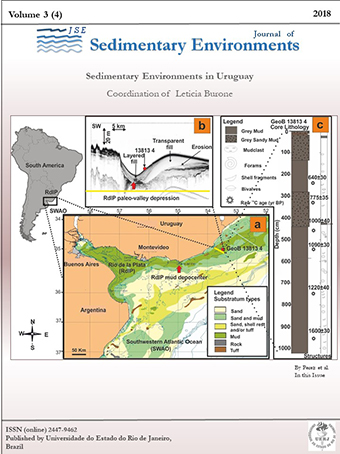SEISMIC STRATIGRAPHY OF THE EOCENE–LOWER OLIGOCENE IN THE URUGUAYAN CONTINENTAL MARGIN / ESTRATIGRAFIA SÍSMICA DO EOCENO AO OLIGOCENO INFERIOR NA MARGEM CONTINENTAL URUGUAIA
DOI:
https://doi.org/10.12957/jse.2018.39248Keywords:
Eocene. Sedimentary Basins of Uruguay. Sequence stratigraphy. Stratal Stacking Patterns / Palavras-chave, Eoceno. Bacias Sedimentares do Uruguai. Estratigrafia de Seqüências. Padrões de Empilhamento EstratalAbstract
The Uruguayan continental margin was generated following the fragmentation of the Gondwana supercontinent and the subsequent opening of South Atlantic Ocean. It constitutes an extensive sedimentation area in which three sedimentary basins can be found: the Punta del Este Basin, the southernmost portion of the Pelotas Basin, and the poorly defined Oriental del Plata Basin. The aim of this work was the identification and characterization of the different seismic units (seismic facies, systems tracts, depositional sequences) for the sedimentary interval assigned to the Eocene in the Uruguayan continental margin. Sequence stratigraphy was used as a basin analysis method for this purpose, using a database that consisted of approximately 10,000 kilometers of 2D seismic sections, acquired in exploratory surveys in 2007 and 2008. The workflow included the recognition of stacking patterns and/or stratal terminations, the definition of genetically significant stratigraphic surfaces and, based on these, the identification of systems tracts and depositional sequences. Three depositional sequences were identified in the studied sedimentary interval. The basal sequence is composed of four depositional systems tracts, including falling stage, normal regression (lowstand and highstand) and transgressive deposits. The intermediate sequence only preserves lowstand normal regression deposits. The third sequence is composed by three depositional systems tracts, including lowstand, transgressive and falling stage deposits.
Resumo
A margem continental uruguaia foi gerada após a fragmentação do supercontinente Gondwana e a subsequente abertura do Oceano Atlântico Sul. Constitui uma extensa área de sedimentação em três bacias sedimentares: a bacia de Punta del Este, a porção mais ao sul da Bacia de Pelotas e a Bacia Oriental del Plata, pouco definida. O objetivo deste trabalho foi a identificação e caracterização das diferentes unidades sísmicas (fácies sísmicas, tratos de sistemas, seqüências deposicionais) para o intervalo sedimentar atribuído ao Eoceno na margem continental uruguaia. Com este objetivo, utilizou-se a estratigrafia de seqüencias como método de análise de bacias, tendo-se utilizado um banco de dados constituído por aproximadamente 10.000 km de seções sísmicas 2D, adquiridas em pesquisas exploratórias em 2007 e 2008. O trabalho incluiu o reconhecimento de padrões de empilhamento e/ou terminações estratais, a definição de superfícies estratigráficas geneticamente significativas, tendo-se efetuado com base nelas, a identificação de tratos de sistemas e seqüências deposicionais. Três seqüências deposicionais foram identificadas no intervalo sedimentar estudado. A seqüência basal é composta por quatro tratos de sistemas deposicionais, incluindo a fase de abaixamento do nível do mar, a regressão normal e depósitos transgressivos. A sequência intermediária apenas preserva os depósitos de regressão normais de nível de mar baixo. A terceira seqüência é composta por três tratos de sistemas deposicionais, incluindo depósitos de nível de mar baixo, transgressivos e de abaixamento do nível do mar.
Downloads
Published
Issue
Section
License

Journal of Sedimentary Environments (JSE) is licensed under a Creative Commons Attribution-Noncommercial-Share Alike 4.0 International License.

